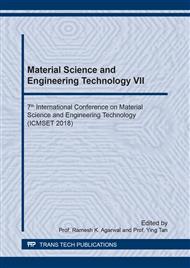p.75
p.80
p.85
p.90
p.97
p.103
p.110
p.117
p.123
Synthesis and Electromagnetic Shielding Properties of Graphene-Fe3O4-BaTiO3/ Silicone Rubber Nanocomposites
Abstract:
A two-step solvothermal method was employed to synthesize the Graphene/Fe3O4/BaTiO3 (GFT). X-ray diffraction (XRD), scanning electron microscopy (SEM), Raman spectra are used to observe the microstructure and magnetic properties of GFT, and the nanoparticles of Fe3O4 and BaTiO3 were uniformly deposited on the surface of the graphene nanosheets. Then GFT filler and the silicone rubber were mixed to manufacture the electromagnetic shielding materials. The vector network analyzer was employed to evaluate the electromagnetic shielding effectiveness of the modified electromagnetic shielding materials. The influence of the mole ratio of the GFT constituents, the mass content of the filler on the electromagnetic shielding effectiveness was studied between 1 GHz and 20 GHz. It is shown that the GFT/silicone rubber has the best electromagnetic shielding effectiveness for 24:1:1 of graphene: Fe3O4: BaTiO3 and 16 % GFT.
Info:
Periodical:
Pages:
97-102
Citation:
Online since:
April 2019
Authors:
Keywords:
Price:
Сopyright:
© 2019 Trans Tech Publications Ltd. All Rights Reserved
Share:
Citation:


